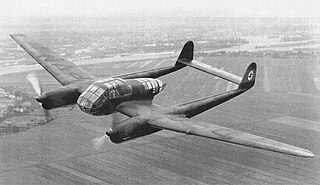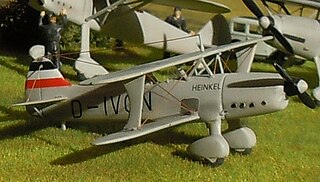
The Arado Ar 80 was a pre-World War II fighter aircraft, designed by Arado Flugzeugwerke to compete for the Luftwaffe's first major fighter contract. The Ar 80 was uninspiring in terms of performance and also suffered a number of failures. The contest was eventually won by the Messerschmitt Bf 109, and the Ar 80 prototypes ended their days as test aircraft.

Focke-Wulf Flugzeugbau AG was a German manufacturer of civil and military aircraft before and during World War II. Many of the company's successful fighter aircraft designs were slight modifications of the Focke-Wulf Fw 190. It is one of the predecessor companies of today's Airbus.

The Focke-Wulf Fw 187 Falke ("Falcon") was a German aircraft designed in 1935. It was conceived by Kurt Tank as a twin-engine, high-performance fighter, but the Luftwaffe saw no role for the design, perceiving it as intermediate between the Messerschmitt Bf 109 and Bf 110. Later prototypes were adapted to two-seats to compete with the Bf 110 in the heavy fighter (Zerstörer) role, but only nine aircraft were built in total.

The Focke-Wulf Fw 189 Uhu (Owl) is a twin-engine twin-boom tactical reconnaissance and army cooperation aircraft designed and produced by the German aircraft manufacturer Focke-Wulf. It was one of the Luftwaffe's most prominent short range reconnaissance aircraft during the Second World War.
Arado Flugzeugwerke was a German aircraft manufacturer, originally established as the Warnemünde factory of the Flugzeugbau Friedrichshafen firm, which produced land-based military aircraft and seaplanes during the First and Second World Wars.
Bücker-Flugzeugbau GmbH was a German aircraft manufacturer founded in 1932. It was most notable for Its highly regarded sports planes which went on to be used as trainers by the Luftwaffe during World War II.

Oschersleben is a town in the Börde district, in Saxony-Anhalt, Germany. The population in 1905 was 13,271, in 2020 about 19,000.

The Argus As 10 was a German-designed and built, air-cooled 90° cylinder bank-angle inverted V8 "low power" aircraft engine, used mainly in training aircraft such as the Arado Ar 66 and Focke-Wulf Fw 56 Stösser and other small short-range reconnaissance and communications aircraft like the Fieseler Fi 156 Storch during, and shortly after World War II. It was first built in 1928.

Pfalz Flugzeugwerke was a World War I German aircraft manufacturer, located at the Speyer airfield in the Palatinate. They are best known for their series of fighters, notably the Pfalz D.III and Pfalz D.XII. The company went bankrupt after the Armistice, when the French occupation forces confiscated all of the equipment, but the factory was re-used by various other companies until re-forming in 1997. Today they are a parts manufacturer referred to as PFW.

The Focke-Wulf Fw 56 Stösser was a single-engine parasol wing monoplane advanced trainer designed and built by the German aircraft manufacturer Focke-Wulf. It was the company's first aircraft to be designed from the onset by the aeronautical engineer Kurt Tank, who also named the type.

The Heinkel He 74 was a light fighter aircraft developed in Germany in the early 1930s. It was a conventional, single-bay biplane with staggered, unequal-span wings braced with an I-type interplane strut. The pilot sat in an open cockpit, and the undercarriage was of the fixed, tailskid type.
Blitz Week was a period of United States Army Air Forces (USAAF) aerial bombardment during the 1943 Combined Bomber Offensive of World War II. Air raids were conducted on six of seven days as part of Operation Gomorrah, against targets such as the chemical plant at Herøya, Norway, which produced nitrates for explosives; and the AGO Flugzeugwerke AG plant at Oschersleben, Germany that assembled Focke-Wulf Fw 190s. The Kassel mission on July 28, 1943, was the first use of auxiliary external fuel tanks on the P-47 Thunderbolt.

The Focke-Wulf Fw 62 was a reconnaissance floatplane, designed and built by Focke-Wulf for use by Nazi Germany's Kriegsmarine. Only four were built.

The Arado Ar 198 was a prototype reconnaissance aircraft, developed by Arado Flugzeugwerke, with backing from the Luftwaffe, who initially preferred it over the Blohm & Voss BV 141 and the Focke-Wulf Fw 189. However, when flight tests were carried out the aircraft performed poorly and did not impress the Luftwaffe. One aircraft was completed in 1938.
The German Air Ministry had a system for aircraft designation which was an attempt by the aviation authorities of the Third Reich to standardize and produce an identifier for each airframe type produced in Germany. It was in use from 1933 to 1945 though many pre-1933 aircraft were included and the system had changes over those years. As well as aircraft of the Luftwaffe, it covered civilian airliners and sport planes, due to the RLM handing all aviation-related matters in the Third Reich, both civilian and military in nature.











